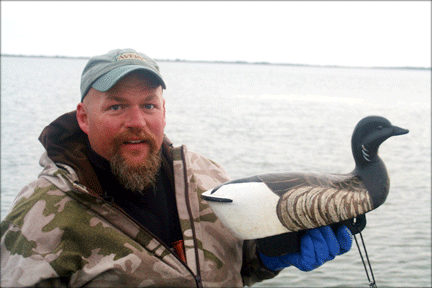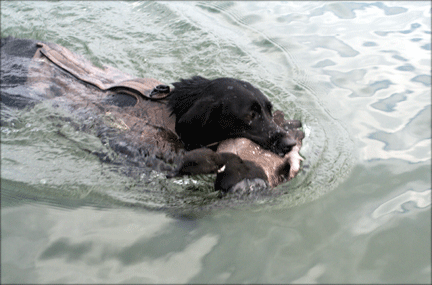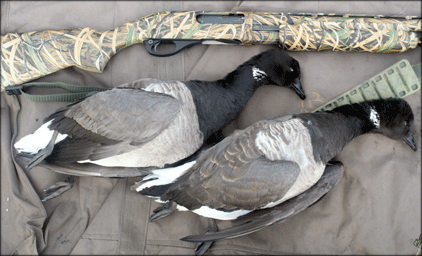Ode to the Atlantic Brant
Most fantasies are better than the actual experience. Occasionally the opposite is true, a well known fact of hunters around Maryland.
Waterfowlers dream of someday hunting the Eastern Shore. Magazine articles during my youth described hunting this coveted area for sea ducks, Canada geese and Atlantic brant, a mystery goose, to hunters living away from coastal areas. Most references I found in books or magazines spoke of brant blundering in during sea duck hunts.
A Maryland waterfowl biologist once told me, “Mainly hunters from other places hunt brant, only guides from here chase this bird and always with clients. Most of us who live here have never found a way to make that damned goose taste good, but the damned things are fun to hunt.”
I wondered how many brant were actually prepared for dining these days, considering this short-winged goose was sold in large numbers to restaurants during the dark market hunting era. No doubt most today are sent to the taxidermist and fixings are saved for the more succulent Canada geese.
Locals claim to not eat them and perhaps only non-residents would attempt any type of dining preparation, no doubt with less than desirable results. Yet, early outdoor writers left a mystique about the Atlantic brant that made many of us yearn to learn more.
My chance to hunt Atlantic brant came with an invitation from my friend, Christina Holden, a Maryland resident. We loaded gear in a tender boat on a chilly day when most stayed indoors.

Cold air immediately reddened our faces while Jeffrey Coats, a superb Eastern Shore guide turned his camouflaged boat into Chincoteague Bay. Bags of brant decoys made comfortable seats. A brisk January breeze tried to cut though my best rain suit that was backed by some of the finest cold-weather undergarments. I spent many years being cold in my youth and plan to stay warm during the second half of my life.
We quickly cleared the small harbor and Coats kicked the big engine in high gear. The boat’s momentum slipping through shallow bay water occasionally flushed a sprinkling of sea ducks into flight and provided ample time for me to reflect on the area’s remarkable waterfowl history.
I had little trouble visualizing hunters digging holes to plant sink boxes on sandy or mud beaches. A gaggle of live decoys would be placed out in front to quack or honk their heads off at passing flocks that circled and then settled in for an easy harvest, a practice outlawed since 1935.
My eyes focused on a distant black line on the bay’s surface proving to be surf scoter, a much sought after sea duck. Hunters once floated close to flocks in boats with bow mounted cannons. They set off their battery of flying shrapnel into large numbers of ducks or geese.
I thanked God that those times ended before most waterfowl become extinct. Waterfowling history adds interest to this beautiful area in a day before good camouflage and boats with huge motors. Many hunters of that era were expert callers who took large numbers of ducks and geese compared to our modern daily limits.
My daydream ended when Coats cut his outboard motor and started drifting toward a shallow area alongside an uninhabited strip of land. We set out bags of brant decoys hand carved by the talented guide and numerous V-boards, each holding three or four brant silhouettes. I wondered if the cautious geese would visit our spot in this vast area of water. I was assured that a good set of decoys over underwater eel grass and sea lettuce would draw the lines of brant.
I closed my eyes and remembered the words written in 1905, “A Close Call,” by Alexander Hunter.
“But he may sit in a land blind during the whole winter and never see a brant hovering over the decoys, for that wary game bird gives a wide berth to marsh, cape, island or mainland and feeds only in the open a half mile or more from shore. In the early morning and late evening they ride the waters in vast numbers and are quick to take flight at the sight of any craft.”
I soon understood the mystery, our query presented a challenge. Coats was said to be the best living guide for brant, so chances were good that primer caps would soon be exploded, sending steel shot at a rare goose—at least for a hunter from the Heartland. Perhaps a mature bird would become a trophy for my office wall.
Coats set out the last decoys and V-boards, taking a final glance. He was satisfied that everything looked natural before settling down in the big boat. Camouflage netting over the boat’s top and sides made us less visible to the sharp-eyed birds we planned to hoodwink.
“I use the V-boards for brant because they are visible longer distances than decoys,” Coats explained. Birds sometime come straight in from long distances because they can see other birds. The decoys are needed when birds are closer.”
I thought about what he said while peeking through a slit in the camouflaged canvas. An hour later a flock pushed towards us and Coats started making brant sounds on his call, several high-pitched BRRRRRR’s. They flew straight in and low over the surface, a big difference from Canada geese that will circle several times. Holden stood up and dropped her first brant while I missed—three times.
Damn, missed my first opportunity to shoot a brant I thought. Hope I get another chance.

We stood up and watched as Coat’s black lab, Poacher reached the brant. The eager dog became tangled on two decoy ropes connected to the heavy V-boards while swimming in. Coats motioned the dog to swim back and in different directions until he was freed. I have seldom witnessed better communication between a dog and his owner.
Holden limited out with a second bird on the next pass of brant while my birds continued flying. I glanced down at her shell box, #3 steel shot. I had been shooting BB’s, an old habit from Canada goose hunting. She slipped me some #3’s that I eagerly loaded in my 870 Wingmaster pump 12 gauge with a new surge of hope.
Soon three brant pushed along the shoreline toward our decoys and not over five feet above the surface. I stood up and swung on the first brant, squeezed the trigger and dropped him. The second shot missed, but the third shot dropped the lead goose. I limited out in 30 seconds after changing to smaller shot that offered more pattern.
Coats decided to try for a limit while we visited in the comfortable boat. Camouflaged canvas on the side rose up to hide us from the sharp-eyed brant that do not seem wary like Canada geese. They were smart enough to move down the shoreline to a cove where we watched several hundred birds pass our set to join live birds, ignoring Coat’s calling. Several flew over for a look, but kept pushing on to their live comrades.
“Hard to compete with live birds,” Coats said. “In the evening we’ll start seeing singles and small groups of brant. For now they’re content to sit.”
Two brant left the group a half hour later and bored in towards our set. They did not circle, but came straight in. Coats didn’t call, the brant knew where they wanted to go. They quickly swung over our decoys flying side by side and Coats fired, dropping both with one shot. Poacher swam out and brought in both geese that laid stone dead on the surface.
“That’s the key, save ammunition,” Coats said while we rolled our eyes.
That evening we dined at the Crab Alley Restaurant, in West Ocean City, Maryland. I took a big bite of Crab Imperial, a white sauce with big chunks of fresh crab meat poured over a flounder fillet. I should have enjoyed the meal more, but I couldn’t stop thinking about the brant flying towards our decoys, getting bigger and bigger until they set their wings and hung out like piñatas on a string. I would see the same sight while trying to sleep that night. I didn’t sleep much knowing that we were hunting the following morning.
George Zahradka, of Middle River, Maryland. and Wayne Radcliffe, of Glen Arm, Maryland., two veteran Eastern Shore hunters, set out several dozen brant decoys and V-boards on a small island the following morning before daylight. The grass-covered isle sat directly in sight of where we had hunted the evening before. This time, we hunted on the island, in camouflage that was darker colored than our surroundings. Holden leaned against a supply pack while I positioned against an old abandoned crab trap cushioned with decoy bags.

“The key is staying perfectly still,” Zahradka said. “We should pick up singles and small groups of brants, maybe a couple of ducks.”
Soon a dark shape winged towards our decoy set. Holden, after out shooting me for two days and no doubt feeling sorry for the old man whispered, “You take this one.”
I watched the brant flying in a straight line before executing a sharp right turn and landing in the decoys. I leaned up and spooked the brant to flight. He had barely lifted off when a load of #3 steel shot dropped him back down among the decoys.
“If you had missed, I had your back,” the ornery Holden said. “I was on him too, good thing you didn’t miss.”
“Good start,” Zahradka said. “There should be more.”
His prophesy proved to be correct as a long string of at least 50 birds flew down across the bay and straight towards our set. Three birds flew lower than the rest and dropped down for a closer look at our decoys. Holden had the shot and swung on the last bird, squeezed her trigger and dropped the mature brant among the decoys.
The morning brought more strings of brant flying across the channel. Some continued on to another destination while others turned and dropped down to investigate our decoys that spread out a hundred yards. Several dropped into the convenient opening for easy shots. Holden and I limited out on brant by noon and regretfully called it a day when so many sea ducks were in the area. I had a flight to catch.
Hours later I sat on a jet soaring back to Kansas, my wife and home. Visions of long strings of brant turning towards our decoys clouded my thoughts and I realized why writers of the past passionately described brant when so many other desirable table-fare fowl flooded the Eastern Shore. My waterfowl biologist friend had said it all, “The damned things are just fun to hunt.”
Kenneth L. Kieser is a veteran outdoor writer of more than 25 years and author of the western novel “Ride the Trail of Death” published by La Frontera Publishing. You can contact him at letters@shotgunlife.com.
For more information about hunting with Capt. Jeffery Coats, call (410) 410-937-4034 or email him at jeff@pitbosswaterfowl.com and you can check his web site at: www.pitbosswaterfowl.com.
For more information about hunting waterfowl in Maryland, contact the Maryland Department of Natural Resources at: 410-260-8540 or check their web site at: www.dnr.maryland.gov.


Comments